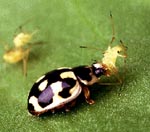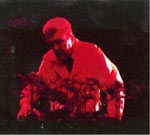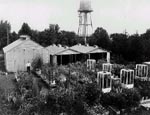|
|
|
 |
| 1960-1969 |
 |
Celebrating Over 90 Years of scientific excellence in agricultural sciences and human nutrition
|

 |
As a result of public concern over environmental quality, Congress appropriated new funds for research. This resulted in:
- Discovery of new, safer insect controls based on isolating natural chemicals such as insect growth regulators--compounds with juvenile hormone-like activity.
- DDT is discovered to cause the reduction of the thickness of egg shells, endangering a number of bird species including the American Bald Eagle.
- Sex pheromones of several insects including the gypsy moth are discovered and synthesized and their usefulness in trapping and control programs is demonstrated.
- Use of predators and parasites for controlling harmful insects is evaluated.
- Movement and fate of pesticides in soil, water and air is determined.
|
 |
 |
Development of the first computerized near-infrared spectrophotometer, which leads to today's $50- to $100-million-a-year industry. This noninvasive technique is used to measure traits like protein, oil, starch and moisture in grain and oilseed; hollow heart in potatoes, water core of apples; fat concentration of milk; and many other uses without destroying the sample.
Microbial methods are developed for determining the amino acid content of protein and determining the nutritive value. |
 |
 |
Identified and characterized phytochrome, the chemical that regulates all aspects of plant growth through the absorption of red light, from germination to flowering to fruiting. This chemical is responsible for photoperoidism discovered in 1919.
548 acres transferred in 1961 to NASA for the construction of Goddard Space Flight Center.
209 acres transferred in 1962 to Food and Drug Administration. |
 |
 |
Research on contagious and foreign livestock diseases is transferred to Plum Island, NY and the National Animal Disease Center in Ames, IA.
About 4,800 people work at Beltsville in 1962. 25% of all USDA research scientists work at Beltsville.
National Agricultural Library constructed in 1967. |
|
|
|
|
|
|
|
Last Modified: 08/22/2005
|
|